2008 VOLKSWAGEN JETTA ESP
[x] Cancel search: ESPPage 306 of 477
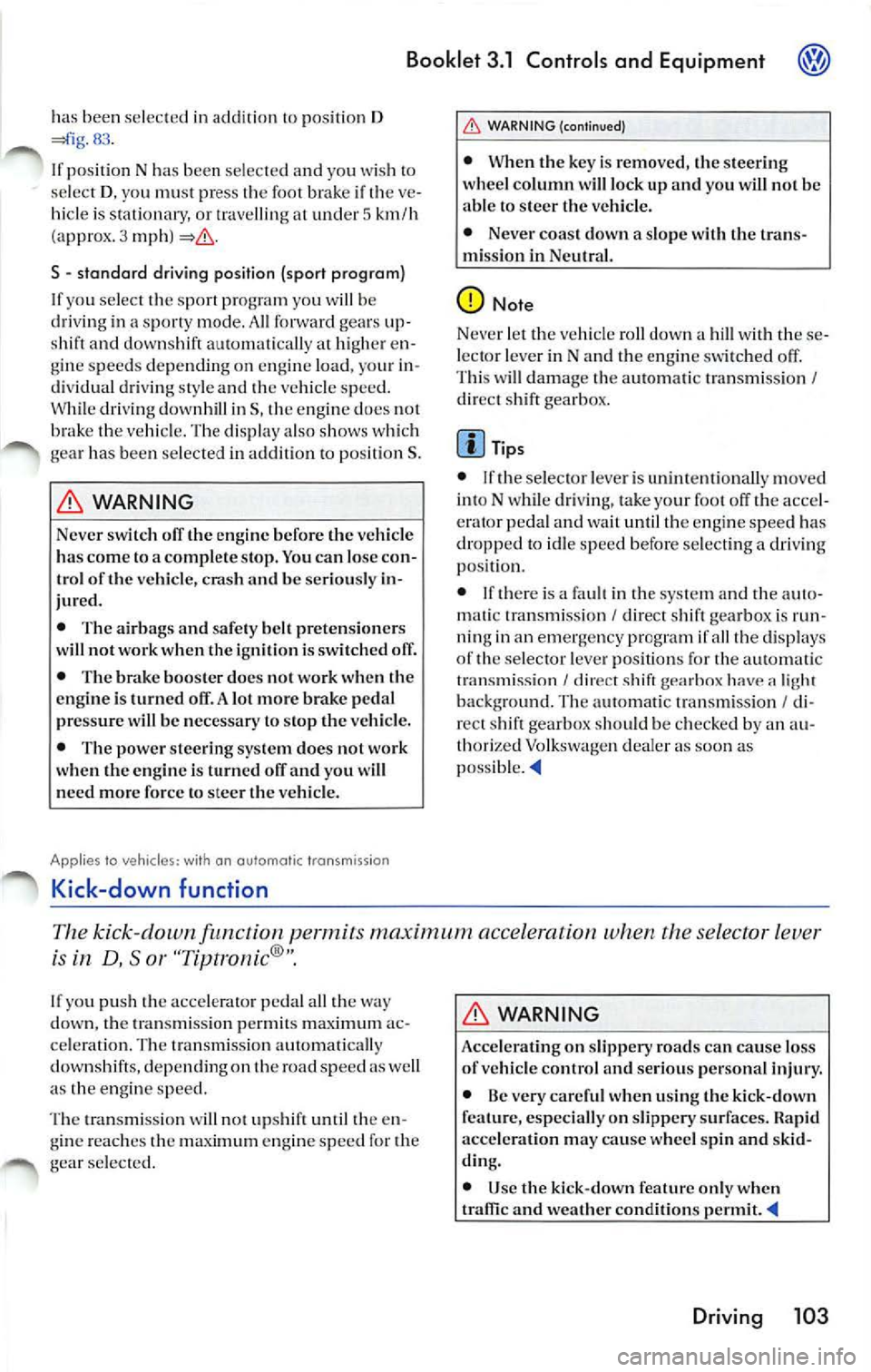
Booklet 3.1 Controls and Equipment
has bee n se lec te d in ad dition to po siti on D 83 .
If po sit io n N h as been selec te d and you wi sh to
se le ct D , yo u mu st pre ss the foot brake if th e ve
hi cle is stat io nary, or travellin g at under 5 km/h
( approx. 3 mph )
S - standard dri ving posit ion {sport program)
If y ou s ele ct t he sport pro gra m yo u will be
dri ving in a sport y mode . A ll forward gear s
shift and down shift automat ically at high er en
g in e s pee ds dep ending on en gin e load , you r in
di vid ual d rivin g sty le and th e ve hicle sp ee d.
W hile dr iv ing downh ill in S, the engin e docs not
the veh icle. Th e displa y al so sh ow s wh ic h
ge ar ha s be en se lec te d in addit io n t o po siti on S .
WARNING
Neve r switch off the engine before the ve hicle
ha s come lo a complete stop. You can lose co n
trol of the vehicl e, crash and be ser iously in
jured.
• The airb ags a nd safe ty bell pretensioners
w ill n ot work when the igniti on i s swi tched off.
• The br ake boo ster do es no t work when the
eng ine i s turn ed off. A lot mor e brak e pedal
pressure will be necessary to stop th e vehicle.
• The power steer ing system does not work
w hen the engine is turn ed off and you will
n eed more force to steer th e ve hicl e.
Applies to vehicles: with on a utoma tic trans missio n
Kick-down function
WARNI NG (continued)
• When the key is removed, th e steer ing
w hee l co lumn will lo ck up and you will not be
able to stee r th e ve hicle.
• Never coast down a slop e w ith th e trans
mi ssio n in Ne utral.
Tips
• If th e selec to r lev er i s un inte nti onal ly mo ved
int o N wh ile dri ving , take your fo ot off t he acc el
era to r p eda l a n d wa it until th e engi ne spee d has
dropp ed to idl e sp ee d before sele c tin g a dri vin g
po sition .
• If th ere is
fa ult in th e sys te m and th e auto
mati c tra nsmi ssion I dir ect shift gearbox is run
n in g in an emergen cy program if all the displays
of the s elector leve r position s for the au tomat ic
tr ansmi ss ion
I di rec t s hi ft g ea rb ox have light
ba ckg ro un d. The a utoma tic tran smi ssio n I di
r ec t shift gearbo x shou ld be c hec ked b y an au
thori zed Vo lkswage n dea ler as soon as
po ssibl e._.
Th e kick -down permits maximum a ccele ration the se lector lev er
is
D, So r
down, th e tran smi ssion p ermi ts a c
c e le ratio n. The tran smi ssio n aut om atica lly
down shift s, de pending on the road spe ed as we ll
a s th e eng ine sp ee d.
Th e tra nsmi ssion
not up sh ift until the en
g in e reac hes the engin e s pee d for th e
g ear sele ct ed .
WARNING
Accelerating on slippe ry road s can cause lo ss
of ve hicle control and serious per sonal injury.
• Be very careful when u sin g th e kick -do wn
especi all y o n sli ppery sur faces. Rapid
accelera tion may ca use w hee l spin and sk id
d in g.
• Use the kick-down fea tur e o nly w hen
and weather conditions permit
Driving 103
Page 309 of 477

Booklet 3.1 Controls and Equipment
Electronic Parking Assistance
Applies to wit h E le ctro nic Perk ing Assis tance
Description of Electronic Parking Assistance
The Electronic Parking Assistance is a parking aid, which draws to
obstacles.
The electro nic parking a ssistanc e he lps th e
dr iver when parking the ve hicle. Th e driv er is
fo rm ed or warned by audibl e signals that hide is approac hing behind ve·
hide. The clo ser yo ur vehicle approach es
obstacle, quicker aud ible sig nal s w ill
so und. Th e audib le s ig nal will sound continu ·
o usly if lh e obs tacle i s very near.
It uses ultrasonic senso rs in rea r bumpers to
measure distanc e lo obstacle s.
Th e se nso rs ar e
lrans miller s and rece ive rs
o f ult rasoun d waves. The e lec tronic syste m s
uses ultra sou nd waves (i.e. transm iss ion, r e·
fl ec lion from th e obstacle a nd rece ption) to
th e di stance th e vehicle and obstacle .
O nc e yo ur vehicl e is very close lo
obstacle, will no longer be det.ec tccl and you
co uld cau se damage lo vehicl e. Always pay
close attention lo audibl e signals lo help you
park your vehicl e.
Switching on the electronic parking assistance
The parking distan ce warni ng
is
s witched on when reverse gea r is selected
and when i g niti on i s on. An audible sig nal is
g iv en. I f yo u do not h ear th is acoustic sig nal.
parking di stan ce wa rning sy stem is n ot on. Hav e sys tem insp ec ted b y yo ur au rized Vo lk swagen deal er.
106 Driving
Switching off the electronic parking assistanc e
Th e parki ng ass istanc e is
off when th e
r e ver se gear is desele cted.
WARNING
The elec troni c parking cannot re
p lace the driver's assessmelll of situation.
T he dri ver is per sonally respons ible for safe
parking and other maneuver s.
• The sensor s ha ve blind spot s in which ob
s tacles an d people are not registered.
•
p arti cul arly aware o f sm all children or
animals when backing up. The sens ors may
not always be abl e to det ect them.
may not way s be abl e dete ct object s such a s draw bar s, thin rails, fences, po sts e tc .
T hi s co uld resu lt in da mag e lo your car.
• The electroni c pa rking as sis tance work s on ly
al sp eeds of und er about 9 mph (15 km/h ).
• The elec troni c park ing senso rs in th e
bump ers mu st be k epl clea n and free of i ce.
When cleanin g wi th pre ssure hoses and
cleaner s, lhe sensors sh ould b e spra yed on ly
b riefly. A distan ce of a t least 0.3 ft. (0. 1 m ete rs)
betwee n th e se nso rs and I hose
nozz le must b e ob se rved.
Page 313 of 477
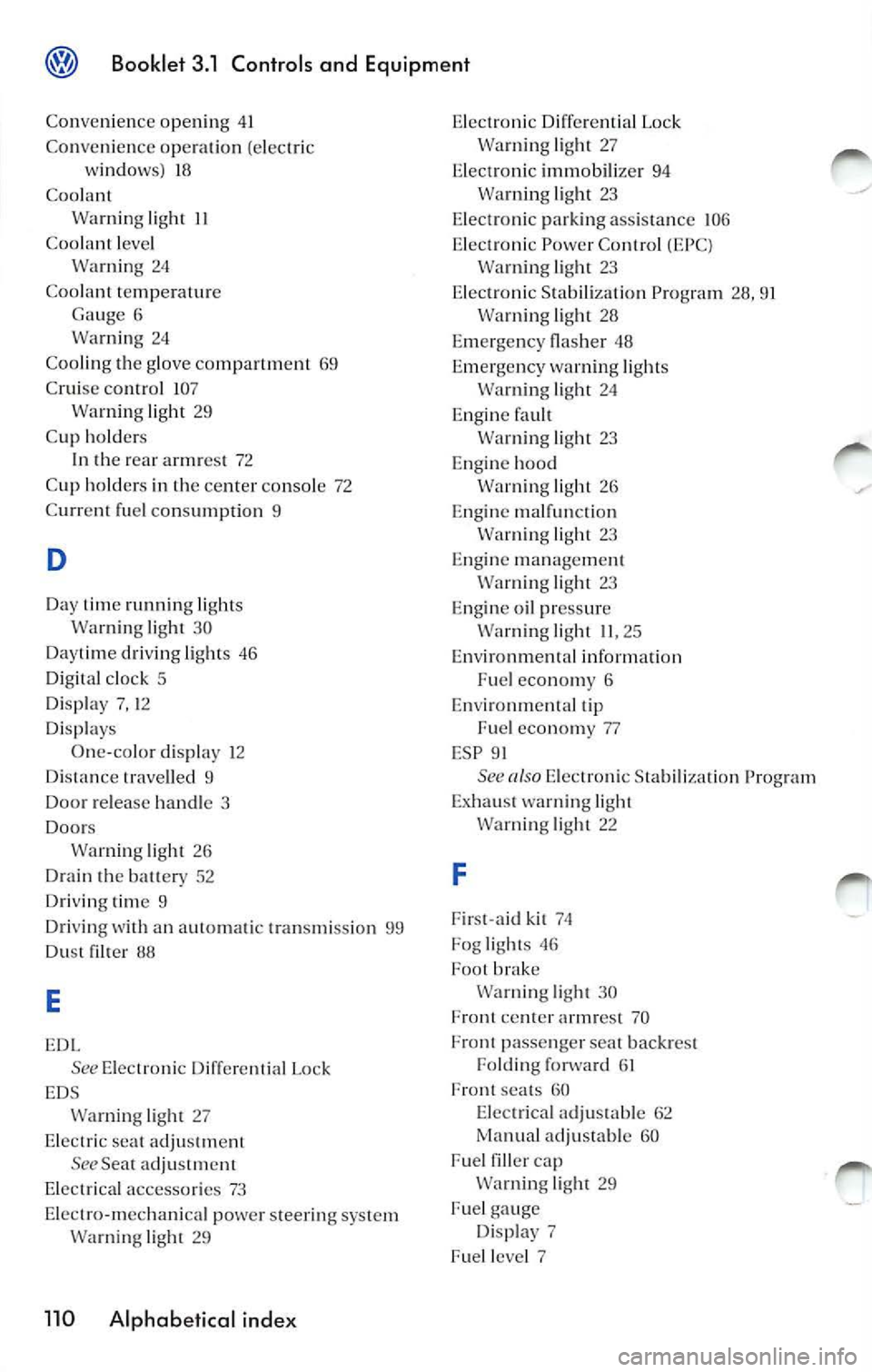
Booklet 3.1 Controls and Equipment
Conve nien ce open ing 41
Conven ie n ce operatio n (elec tric
w ind ows) 18
Coo lant
li ght 11
Coo lant leve l
Warn ing 24
Coo lant te mperature
Gauge 6
Warn ing 24
Coo ling the glo ve
69
C ru ise co111rol 107
Wa rnin g light 29
Cup ho ld ers
I n the rear armrest 72
C up holder s in the center co nso le 72
C urrent f uel cons umption 9
D
Day time runnin g lights
Warning lig ht 30
Daytime dri vin g ligh ts 46
Di gita l c loc k 5
Di sp lay 7, 12
D is plays
One-co lo r display 12
Distance trave lled 9
Door re lease hand le 3
Door s
Wa rnin g lig ht 26
Drain the bauery 52
Driving time 9
Driving
an automatic transmi ssion 99
Dust
88
E
See Electron ic D iffe rentia l Lock
EDS
Wa rnin g light 27
E lec tric seal a djustment
See Seat adj ustme nt
Ele ctrical accessories 73
Elec tro-mechanica l power steering syste m
Warning light 29
110 Alphabetical index
Electron ic Diffe re nti al Lock
Wa rnin g lig ht 27
Electronic immobilize r 94
Wa rnin g light 23
Electro nic parking assistance 106
E lectro nic Power Control (EPC)
light 23
E lec tron ic Stabi liza tion Program 28, 91
Wa rnin g lig ht 28
Emergency
48
E m erge ncy wa rning lights
light 24
Engi ne fault
Warning light 23
E ngin e hood
Warning light 26
E ngin e malfun ction
Warn in g light 23
E ngine mana gement
Warn ing lig ht 23
E ngine oil pr essure
Wa rnin g light 11 , 25
Environmental inform ation
Fuel economy 6
Environmental tip
Fue l economy 77
ESP 91
See E lectronic Stabil ization Program
Exhau st warning light
Warning lig ht 22
F
Firs t- aid kit 74
Fog lig ht s 46
Foo t brak e
Wa rning lig ht 30
cen te r a rmr est 70
Fron t passenger
backre st
Folding forward 6 1
F ront seats 60
E le ctri ca l adj ustab le 62
Manua l ad justab le 60
Fuel filler cap Wa rnin g light 29
Fue l g auge
Di splay 7
Fuel level 7
Page 322 of 477

Table of contents
Smart technology ........... ... .. .. .
Brakes .............. .. .. ..... .. .. .• .....
Po we r stee ring ....... .. ..... ... .. ...... .
Notice about data recorded b y vehicle
contro l modu les ....... ........ .... ..... .
Driving and protecting the
environment ..... ... .... ..... ...... ..
Break-in Pe riod ... ... ........ ......... . ..
Catalytic converter ....... .. .. .. ....... ..
T ra ile r t owi ng . . . . . . . . ... ............ .. .
D riv ing economically o nd respecti ng the
environmen t ... .... ..... ............. ... .
Cleaning and protection ........ . .
General notes .... .... ... ....... .. ...... .
Car e of veh icle exte rior ....... ..• ...... ..
C ore of the vehicle interior ... ..... ..•. ..
Accessories, new parts, repairs
and modifications .......... ...... ..
Accesso ries and pa rts .......... .... .... .
R epa irs and technica l modifications ..... .
Cellu lar phones a nd CB radi os ........ . .
2
2
6
6
7
7
10
10
14
16
16
17
23
27
27
28
29
Booklet 3 .2 Tip s and Advice
Checking and Filling 30
Fill ing the tank . . . . . . . . . .. .. . . .. . . .. . • . . . . 30
Fu el supp ly . .. . . .. . . . . . . . . . . . . . . . . . . . . . . . 32
Working in the eng ine compa rtment . . . . . 34
Engine oil . . . . . . . . . . .. . . .. .. . . . .. .. . . .. . . 37
Coo lant ....... .... .... ...... ... ......... 43
Wos he r fluid and wind shie ld wiper blade s 45
Brok e fluid . . . . . . .. . .. . . . . . . . . . . . .. . . . . . . 47
Vehicle battery . . . . . . . . . .. . .. .. .. . .. . . .. . 49
T ir es and wheels . . . . . . . . . . . . • . . . . . . . . . . . . 51
What do I do now? . .. .. . . .. . . . . .. . 67
Vehicle tools and spore whee l . . . . . . • . . . . . 67
Changing a whe el . . . . . . . . . . . . . .. .. • . . . . . 68
Em erg ency closing or opening . . . • . . . . . . . 7 5
F use s . . . . . . . .. .. . .. .. . . . .. . . . . . . .. . . .. . . . 77
Cha nging a light bulb . .. .. . . . .. .. . • .. . . . 81
Jump start ing . . . . . . . . . . . . . . . . • . . . . . . . . . . . 84
To wing .... ... . . .. . .. .... ....... ... . . .•. . 86
Lifting th e ve hicle .. . .. . . . . . . . . . . . . . .. . . . . 89
C onsumer Info rmat ion . . . . . • . . . . . . 90
Alphabetical index . . . . . . . . . 92
Table of contents
Page 323 of 477
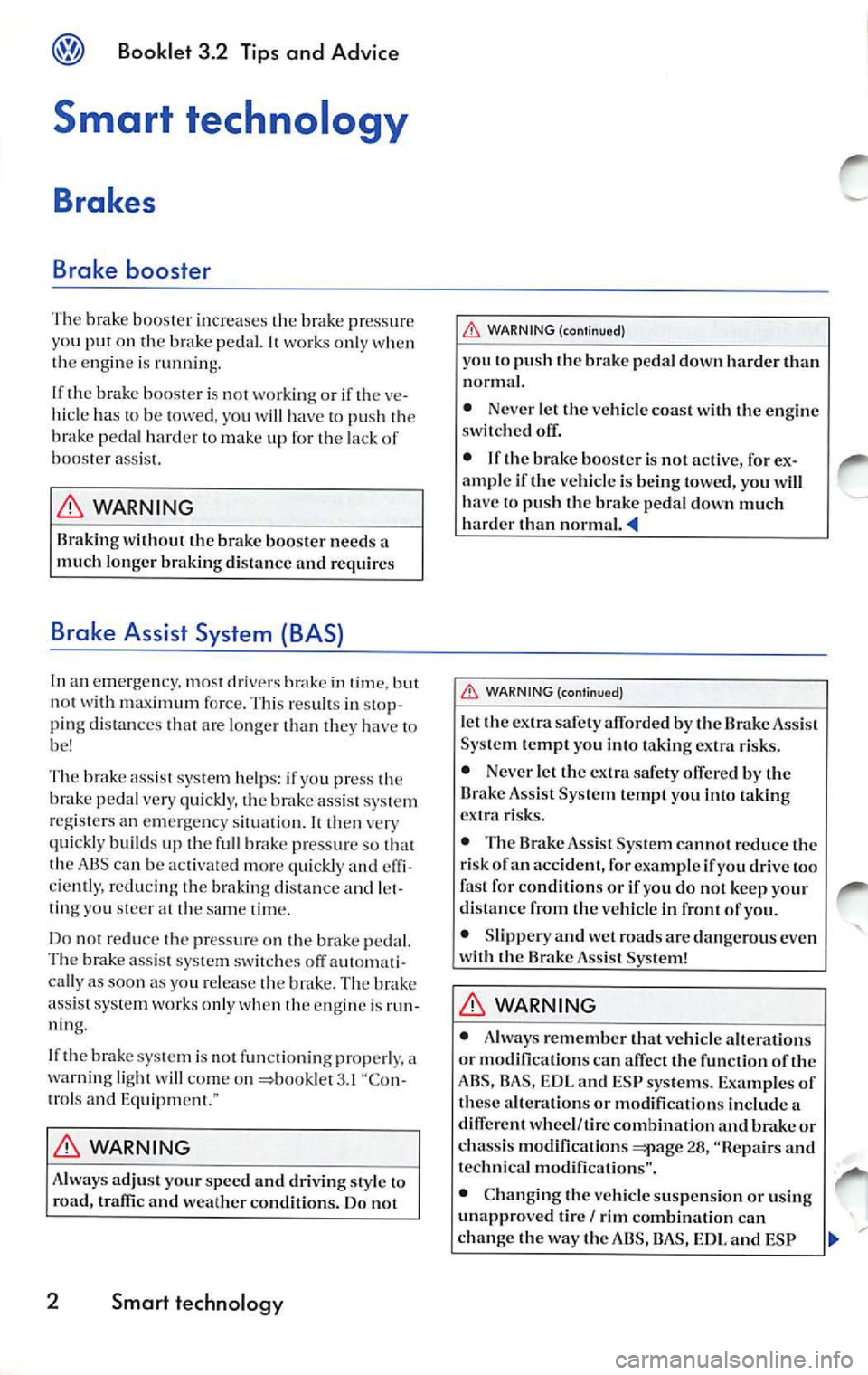
Booklet 3.2 Tips and Advic e
Smart technology
Brakes
Brake booster
The brak e boo ste r incr ea ses the brake press ure
yo u put on th e peda l. wo rk s onl y wh en
t h e engi ne is runnin g.
If th e brak e boos te r is not workin g or if th e ve
hicl e has to be towe d, yo u wi ll h ave
to push th e
brak e peda l hard er to ma ke up for th e lack of
boo ste r ass is t.
WARNING
B rak ing w ithou t t he brake boos ter needs a
mu ch l onge r bra king distance and r equir es
Brake Assist Sys tem (BAS)
In a n emerg ency, mos t d river s brake in t im e, not w ith m aximum force. This res ult s in stop
ping dis tan ces th at are lo ng er th an they have to
b e!
T he brake a ssis t sys te m h elp s: if yo u pr ess th e
brak e pedal very quickly, t he brak e ass is t sy stem
r eg is te rs an em erge ncy situatio n. It th en very
qui ckly build s up th e full brake press ure so th at
t h e A BS can be activate d more qui ckl y and
cie nt ly, r educin g th e braking di sta nce and le t
tin g you steer at the sa me tim e.
D o not reduce th e pr ess ure o n th e brak e ped al.
T he brak e ass is t sys te m sw itches o ff aut omati
ca lly as soon as you re lease th e brake. The brak e
a ss ist sys te m works onl y wh en th e en gin e is
n ing.
If th e brak e sys te m i s not fun ction in g pro perl y, a
wa rnin g lig ht will com e on =bookl et 3.1 "Co n
t rol s and Equipm ent ."
WARNING
Always ad just you r sp ee d an d driv in g s ty le to
roa d, an d weather cond iti ons. Do not
2 Smart t echnology
WARN ING (con tinued)
yo u to p ush th e bra ke ped a l d ow n ha rder th an
n or mal.
• Never let th e ve hicle coa st w ith th e eng ine
switc hed off.
• If th e brake boos te r is no t ac tive, for
ample if th e ve hicle is bein g towed , yo u w ill
have to p ush th e brake pedal down much
h ar der than n ormal.
WARN ING (continu ed)
let the extra safety afforde d b y th e Brake Ass is t
Syste m temp t yo u int o taking ex tra ri sks.
• Never let t he extra sa fety offered by t he
Brak e Ass is t Sy ste m te mpt you into ta kin g
ex tra risks.
• The B ra ke As sis t Sys te m canno t re d uce t he
r isk o f a n acci den t, fo r examp le if yo u d rive too
fas t for co nditi on s or
if yo u d o not k eep yo ur
di stance fro m th e vehicl e in fr ont of yo u.
• Slippery and
roa ds are dangero us eve n
w ith th e Brake Assis t Sys te m!
WARNING
• Always reme mber th at ve hicle a ltera tio ns
or modificatio ns ca n affec t th e fu nctio n of th e
ABS, BAS , ED L and ES P sys te m s. Exa mpl es of
these alt era tion s or mo dificatio ns includ e a
di fferen t w hee l/tir e co mbin atio n and bra ke or
chassis modifi catio ns
28, and
t echn ic al m odi ficat io ns".
• Chan ging th e ve hicle su spe nsio n or u sing
un approved tir e
I r im combin atio n ca n ch an ge the w ay the A BS, B AS, EDL a nd ESP
Page 324 of 477
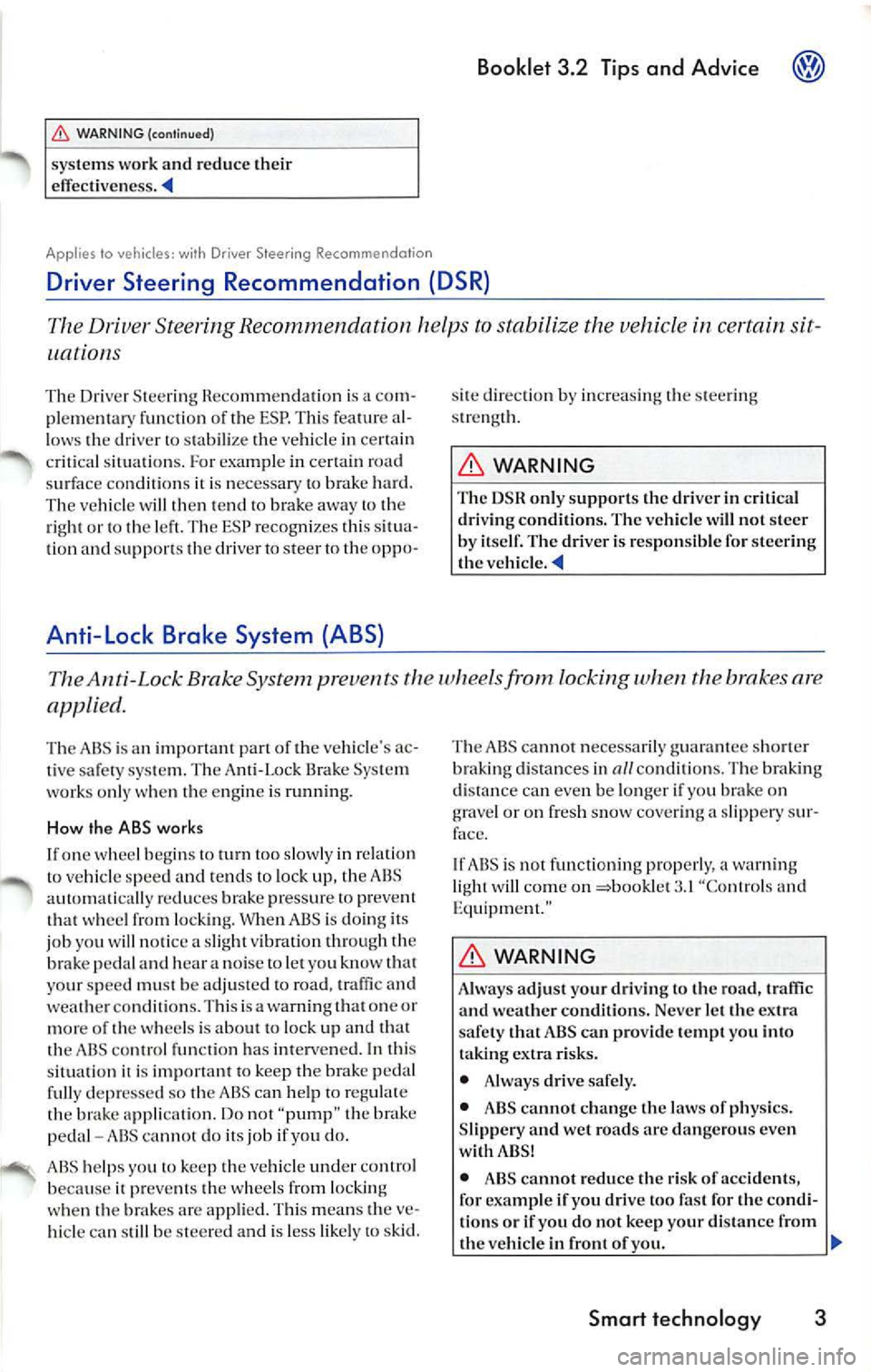
WARNING (continued)
systems work and reduce their
effect iveness.
Applies to vehicles: with Driver Steering Recommenda tion
Booklet 3 .2 Tips and Advice
Driver Steering Recommendation helps to the vehicle in certain sit
uations
The Driver Stee ring R ecomm endation i s a com
pl em entar y function of the ESP. This fea ture al
low s th e driv er
stabilize ve hicl e in certain
critical situati ons. Fo r example in certai n road
s ur face conditi ons ii is necessary to brake hard.
The vehicl e will then te nd to brak e awa y to the
r ig ht or t o 1h e lef t. Th e ESP reco gnizes this situ a
tion and supp ort s the drive r to steer to the oppo-
Anti -Lock Brake System {ABS)
sit e dire cti on by in crea sing th e stee rin g
s tr ength.
WARNING
The DSH only supports the driver in cri tical
dri vin g co ndition s. The ve hicl e will not s teer
by itse lf. The dr ive r is res pon sible fo r steering
the vehicle .
The Anti-Lock Brake System prevent s th e wheels from locking when the brakes are
applied.
Th e ABS is an important part of the vehicle 's ac
ti ve safety system. The Anti-Lo ck Brake Syste m
work s onl y when the en gine is run ning.
How the ABS works
If one w he el begi ns tu t urn too s low ly in r elat io n
t o ve hicl e speed an d le n ds to lock up, t he ABS
a utom ati ca ll y
brak e pres sur e lO preve nt
that whee l fr om locking. When ABS is do ing it s
job you will notice a sli ght vibrati on throu gh the
brake pedal and hea r a noise to l et yo u know tha t
yo ur speed must be adjuste d to road, traffic and
wea ther condi tion s. T his is a warn ing 1hat on e or
mor e of the whee ls is about to lock up and that
th e AB S co ntr ol function has inter vened . In thi s
s ituati on
is important to keep the brak e peda l
fully depr essed so the ABS can help to re gul ate
th e brake applica tion. Do not "pump " th e
peda l -ABS can not do its jo b if you do.
A BS helps you 10 kee p th e ve hicl e und er control
be cause i t prev ent s th e w hee ls from locking
w hen th e brak es arc ap plied. Th is m ean s th e ve
hicl e ca n still be s teer ed and is less likely
on
g rav el o r on fresh sno w cover in g a slipp ery sur
If AB S is not functioning properl y, a wa rnin g
li ght will co me on 3.1 "Co n1rol s and
E quipm ent. "
WARNING
Always ad just yo ur dri vin g to the road, traffic
and weather conditio ns. Neve r le t th e ex tra
s afe ty that ABS can provide te mpt you into
taking extra risks.
• Always drive safely .
• ABS canno t ch ange the
of ph ysics.
S lipp ery and wet roads are dangerou s ev en
wi th ABS!
• ABS ca nnot reduce th e risk of accide nts,
f or examp le if yo u drive too
for the co ndi
ti ons or if you do not keep your distance from
th e vehicle in front of you.
Smart technology 3
Page 325 of 477

Booklet 3.2 Tips and Advice
8 WARNING
• Alw ays remembe r that vehicle alterations
or modifi cation s can affec t the function of the
ABS, BAS, EDL and ESP syste ms. Exampl es of
t h ese a ltera ti ons or modifications include a
diff ere nt wheel/tire combination and brake or
c h ass is modification s =q1age 28, "Repairs and
t ec hni cal modifications".
Electronic differential lock {EDL)
WARNING (continued)
• Changing the vehicl e suspension or usin g
unapp roved tire I rim combination can
c h ange the way the ABS, BAS, EDL and ESP
sys tems work and re duc e th eir elJect iveness.
• The eff ec tiveness of ABS is a ls o d etermined
b y th e tir es on your vehicle
51, "Tires
and wheels"
The elect roni c differential lock helps red uce th e los s of traction if a wheel starts
s pinnin g.
T he E DL help s th e ve hicle mov ing, accel
era te and climb a gradient when t he going ge ts
s li pp ery where m ov ing ahea d ma y otherw ise be
diffi cult or eve n im possibl e. EOL u ses the AB S
se nso rs to monito r th e spe ed of t he w hee ls.
EDL works on ly when the eng ine is runnin g.
EDL can help to ba la nce out differen ces in the
rotat io n of the w hee ls of a ppro ximat ely
JOO rpm
ca use d by sli ppery gro und surface on side of the vehicl e. It do es thi s by braking th e whee l
t h a t h as los t tracti on and d is tributing more
d riv ing fo rce to the oth er d riven wheel v ia th e
diff ere nt ia l
E DL is ac tive at sp ee ds up to a bout
50 m ph (80 km /h).
E DL autom atically shut s
to pr event th e di sc
brak e of th e w hee l from over heating
under excess ive loa ds. Th e ve hicle re main s op
era tional the
way as ve hicl e without EDL.
For this reas on. the dri ver is not in form ed tha t
t h e EDL has been shu t
ED L w ill auto matica lly sw itch on again when th e
br ake ha s coo le d down.
4 Smart technology
8 WARNING
Always adjus t your driving to the road, and weather condition s. Never le t th e ex tra
sa fe ty that EDL can prov ide te mpt you into
takin g extra ri sks.
• When accelerating on a slippery surfa ce,
for example on ice a nd snow , pr ess the acce l
e rator care full y. De spite ED L, th e w hee ls may
s ta rt to spin lead ing to a loss of vehicle control.
8 WARNING
• Always remember that vehicl e alt erations
o r modifi cation s can affect the fun ction of the
AB S, BAS, EDL and ESP sys tems . Exa mple s of
th ese alt era tion s or modifications include a
di!Tcrenl wheel/tire combination and brake or
chass is modifications =q1age 28, "Repair s and
t ec hni cal m odi fication s".
• Changin g t he vehicle su spen sio n or using
u napprove d tire
I rim comb ination ca n
c hang e the way the ABS , BAS, EDL and ESP
systems work and reduce their
effective ness
Page 326 of 477
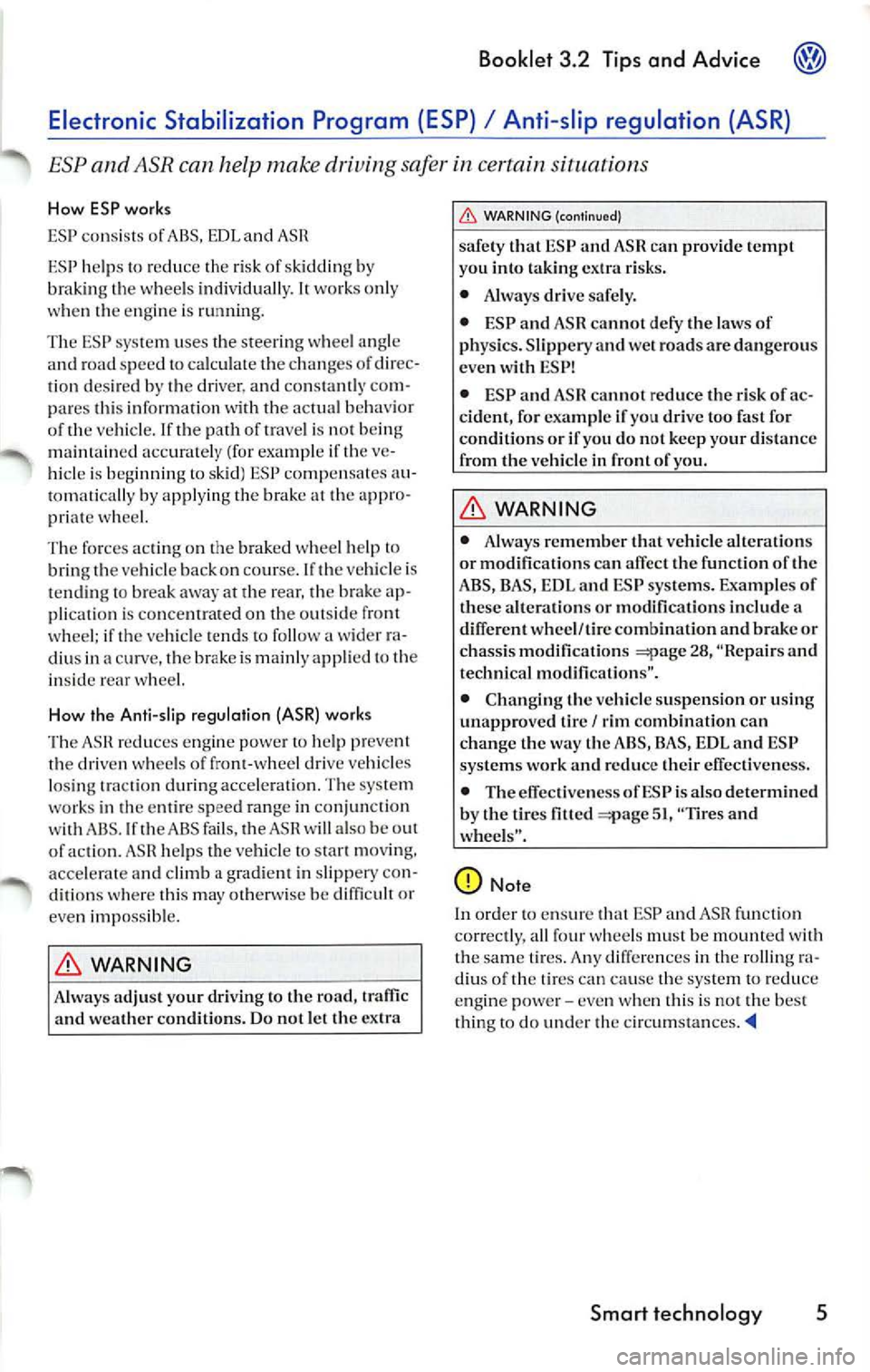
Booklet 3.2 Tips and Advice
help s th e ve hicl e to sta rt mov ing.
a cc ele rat e a nd climb a grad ient in slipp ery con
di tio ns w her e thi s m ay other wise be diffi cult or
ev en impo ssibl e.
WARNING
Alway s adj ust you r driving to the road, traffic
a nd weather condition s. Do not l et the extra
WARNING (cont inu ed)
safety that ESP and can provid e tempt
yo u into taking extra risks.
• Always drive safely .
• ESP and ASH can not defy the laws of
physics. Slipp ery and wet roads are dange rous
even with ESP!
• ESP and AS H cannot reduce the risk of ac
cident, for examp le if you drive too fast for
condi tions or if yo u do not keep your distance
from the vehicle in front of yo u.
WARNING
• Alway s remember that vehicle alterations
or modifi cations ca n the function of the
ABS, BAS, EDL and ESP sys tems. Examp les of
these altera tio ns or modifications include a
different wheel/tire combination and brake or
c h ass is modifications
28, "Repa irs and
technical modifications".
• Chan ging the vehicle suspension or usi ng
un approve d tire
I rim comb ination can
change the way the ABS, BAS, E DL and ESP
sys te ms work and red uce their effective ness.
• The elJec tivencss of ESP is also determined
b y the tires fitted
51, "Tires and
wheels ".
d iu s o f th e tir es ca n c ause the syste m to re du ce
e n gin e po we r - eve n w hen thi s is not th e bes t
thing
to d o und er th e ci rc um stan ces . '4
Smart technology 5